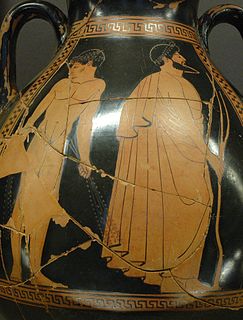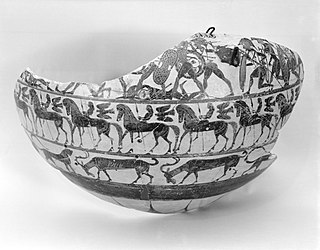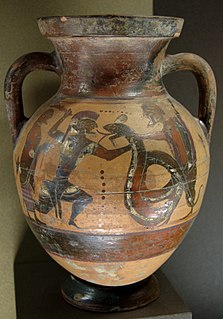
Ancient Greek pottery, due to its relative durability, comprises a large part of the archaeological record of ancient Greece, and since there is so much of it, it has exerted a disproportionately large influence on our understanding of Greek society. The shards of pots discarded or buried in the 1st millennium BC are still the best guide available to understand the customary life and mind of the ancient Greeks. There were several vessels produced locally for everyday and kitchen use, yet finer pottery from regions such as Attica was imported by other civilizations throughout the Mediterranean, such as the Etruscans in Italy. There were various specific regional varieties, such as the South Italian ancient Greek pottery.

Black-figure pottery painting, also known as the black-figure style or black-figure ceramic is one of the styles of painting on antique Greek vases. It was especially common between the 7th and 5th centuries BC, although there are specimens dating as late as the 2nd century BC. Stylistically it can be distinguished from the preceding orientalizing period and the subsequent red-figure pottery style.

Exekias was an ancient Greek vase-painter and potter who was active in Athens between roughly 545 BC and 530 BC. Exekias worked mainly in the black-figure technique, which involved the painting of scenes using a clay slip that fired to black, with details created through incision. Exekias is regarded by art historians as an artistic visionary whose masterful use of incision and psychologically sensitive compositions mark him as one of the greatest of all Attic vase painters. The Andokides painter and the Lysippides Painter are thought to have been students of Exekias.

Red-figure vase painting is one of the most important styles of figural Greek vase painting.

Sophilos was an Attic potter and vase painter in the black-figure style. Sophilos is the oldest Attic vase painter so far to be known by his true name. Fragments of two wine basins ('’dinoi’’) in Athens are signed by him, indicating that he both potted and painted them. In total, 37 vessels are ascribed to him, mostly amphorae, '’dinoi’’, kraters, as well as three pinakes. Apart from his work for the domestic market, he was also one of the masters of major significance in the process of supplanting the dominance of Corinthian vase painting in the markets of Etruria, and Southern Italy, the most important export area for Greek vases. His works were exported as far as the Black Sea region, Syria and Egypt (Naukratis). He was one of the first painters to use additional colours at a grand scale, thus increasing the optical and artistic distinction between Corinthian and Attic vase painting. While he was conservative and traditionalist in terms of the ornamentation and animal figures he used, his intervening figural scenes, mostly of mythological motifs, were entirely innovative. He broke up established standard scenes, had figures act individually, and found clever and unconventional new ways of structuring the narrative. As his artistic style progressed, he increasingly pushed ornamental designs into the margin, as his figural scenes became more and more important. Stylistically, his work is close to that of the late Gorgon painter, whose style he developed further, to be continued later by Klitias, and culminate in the François vase. In spite of his innovative pictorial compositions and his talent to constantly invent new scenes; his drawing style was usually not very accurate. The overall impact of his works is hardly diminished by that.

The Kleophrades Painter is the name given to the anonymous red-figure Athenian vase painter, who was active from approximately 510 – 470 BCE and whose work, considered amongst the finest of the red figure style, is identified by its stylistic traits.

Euphronios was an ancient Greek vase painter and potter, active in Athens in the late 6th and early 5th centuries BC. As part of the so-called "Pioneer Group,", Euphronios was one of the most important artists of the red-figure technique. His works place him at the transition from Late Archaic to Early Classical art, and he is one of the first known artists in history to have signed his work.

Psiax was an Attic vase painter of the transitional period between the black-figure and red-figure styles. His works date to circa 525 to 505 BC and comprise about 60 surviving vases, two of which bear his signature. Initially he was allocated the name Menon Painter by John Beazley. Only later was it realised that the artist was identical with the painters signing as Psiax.
Geometric art is a phase of Greek art, characterized largely by geometric motifs in vase painting, that flourished towards the end of the Greek Dark Ages, circa 900 BC – 700 BC. Its center was in Athens, and from there the style spread among the trading cities of the Aegean. The Greek Dark Ages are also called the Geometric period in reference to this characteristic pottery style, although the historical period is much longer than the art-historical period, being circa 1100 – 800 BC. The vases had various uses or purposes within Greek society, including, but not limited to, funerary vases and symposium vases.

The Kerch style, also referred to as Kerch vases, is an archaeological term describing vases from the final phase of Attic red-figure pottery production. Their exact chronology remains problematic, but they are generally assumed to have been produced roughly between 375 and 330/20 BC. The style is characterized by slender mannered figures and a polychromatism given to it by the use of white paint and gilding.

The Amasis Painter was an ancient Greek vase painter who worked in the black-figure technique. He owes his name to the signature of the potter Amasis, who signed 12 works painted by the same hand. At the time of the exhibition, "The Amasis Painter and His World" (1985), 132 vases had been attributed to this artist.
The Lysippides Painter worked in Athens in the second half of the 6th century BC. He was a black-figure painter of a classic style. He most probably trained with Exekias in his workshop until moving to the Andokides workshop where he mainly painted large, expensive vases and did some work on bilingual vases with Andokides P being the red-figure painter. He was named, after much debate ensuring he was not the Andokides Painter using red-figure, after a Kalos found on one of his vases.

Dodwell Painter was an ancient Corinthian vase painter in the black-figure style whose real name is rather unknown. He was active during the Middle and Late Corinthian periods and his works dates back to 580 to 570 BC.

The Cavalcade Painter is the conventional name for an ancient Greek vase painter who produced Corinthian black figure vases. He was active during the Middle Corinthian period, around 580 BC.

The Swing Painter was an Attic black-figure vase painter, active in the third quarter of the sixth century BC. His real name is unknown.

The Lysippides Painter was an Attic vase painter in the black-figure style. He was active around 530 to 510 BC. His real name is not known.

Euboean vase painting was a regional style of ancient Greek vase painting, prevalent on the island of Euboea.

Etruscan vase painting was produced from the 7th through the 4th centuries BC, and is a major element in Etruscan art. It was strongly influenced by Greek vase painting, and followed the main trends in style over the period. Besides being producers in their own right, the Etruscans were the main export market for Greek pottery outside Greece, and some Greek painters probably moved to Etruria, where richly decorated vases were a standard element of grave inventories.
Cycladic vase painting was a regional style of Greek vase painting, produced in the Cycladic islands.

The Judgement of Paris Amphora is an Attic black-figure amphora named for the scene depicted on it. It is held by the Musée des beaux-arts de Lyon with the inventory number E 581-c and is attributed to the London B76 Painter, who was active at Athens in the second quarter of the sixth century BC.

















